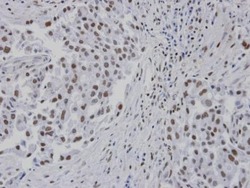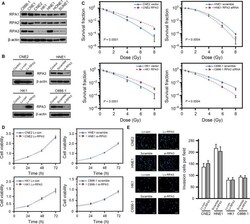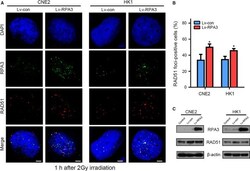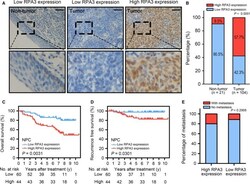Antibody data
- Antibody Data
- Antigen structure
- References [1]
- Comments [0]
- Validations
- Immunohistochemistry [1]
- Other assay [3]
Submit
Validation data
Reference
Comment
Report error
- Product number
- PA5-21277 - Provider product page

- Provider
- Invitrogen Antibodies
- Product name
- RPA14 Polyclonal Antibody
- Antibody type
- Polyclonal
- Antigen
- Recombinant full-length protein
- Description
- Recommended positive controls: 293T. Predicted reactivity: Rhesus Monkey (94%), Bovine (86%). Store product as a concentrated solution. Centrifuge briefly prior to opening the vial.
- Reactivity
- Human
- Host
- Rabbit
- Isotype
- IgG
- Vial size
- 100 μL
- Concentration
- 1 mg/mL
- Storage
- Store at 4°C short term. For long term storage, store at -20°C, avoiding freeze/thaw cycles.
Submitted references RPA3 is a potential marker of prognosis and radioresistance for nasopharyngeal carcinoma.
Qu C, Zhao Y, Feng G, Chen C, Tao Y, Zhou S, Liu S, Chang H, Zeng M, Xia Y
Journal of cellular and molecular medicine 2017 Nov;21(11):2872-2883
Journal of cellular and molecular medicine 2017 Nov;21(11):2872-2883
No comments: Submit comment
Supportive validation
- Submitted by
- Invitrogen Antibodies (provider)
- Main image

- Experimental details
- Immunohistochemical analysis of paraffin-embedded human lung cancer patient tumor, using RPA 14 kDa subunit (Product # PA5-21277) antibody at 1:100 dilution. Antigen Retrieval: EDTA based buffer, pH 8.0, 15 min.
Supportive validation
- Submitted by
- Invitrogen Antibodies (provider)
- Main image

- Experimental details
- Figure 2 RPA 3 regulates the radiosensitivity of nasopharyngeal carcinoma ( NPC ) cells. ( A ) Western blot showing the expression of RPA proteins in different NPC cell lines. ( B ) Western blot showing the effect of RPA 3 overexpression and RPA 3 knockdown in the indicated NPC cells. ( C ) Dose-survival curves of the indicated cells. ( D ) Proliferation curves of the indicated cells. No significant difference was observed. ( E ) The indicated cells were subjected to invasion assays as described. The representative photographs are shown in the left panel, and the right panel shows the quantification of invasion assays. No significant difference was observed. Scale bars, 200 mum.
- Submitted by
- Invitrogen Antibodies (provider)
- Main image

- Experimental details
- Figure 4 Overexpression of RPA 3 enhanced RAD 51 foci formation after irradiation in NPC cells. ( A ) Representative confocal images showing cells immunostained with antibodies against RPA 3 and RAD 51 after irradiation. The indicated cells were irradiated (2 Gy) and immunostained 1 hr later with antibodies against RPA 3 and RAD 51; the nuclei were stained with DAPI . Scale bars, 5 mum. ( B ) Percentage of RAD 51 foci-positive cells. A positive cell was defined by the presence of more than 5 RAD 51 foci. * P < 0.05. ( C ) Western blot showing that the overexpression of RPA 3 did not affect RAD 51 expression.
- Submitted by
- Invitrogen Antibodies (provider)
- Main image

- Experimental details
- Figure 5 High RPA 3 expression predicted a poor prognosis in patients with nasopharyngeal carcinoma ( NPC ). ( A ) Immunohistochemistry ( IHC ) assays for RPA 3 expression in 21 normal epithelium tissues and 104 NPC tissues. The left panel shows that RPA 3 expression was low in normal tissues. The middle panel shows low RPA 3 expression in NPC tissues. The right panel shows high RPA 3 expression in NPC tissues. The lower panels show magnified pictures of the boxed area in the corresponding upper panels. Scale bars, 50 mum. ( B ) RPA 3 expression level was compared between NPC and non-tumour epithelium tissues. ( C ) Overall survival ( OS ) of patients with NPC based on RPA 3 expression. ( D ) Recurrence-free survival ( RFS ) curve of patients with NPC based on RPA 3 expression. ( E ) Cumulative bar chart showing the correlation between RPA 3 expression and distant metastasis in patients with NPC .
 Explore
Explore Validate
Validate Learn
Learn Western blot
Western blot Immunohistochemistry
Immunohistochemistry